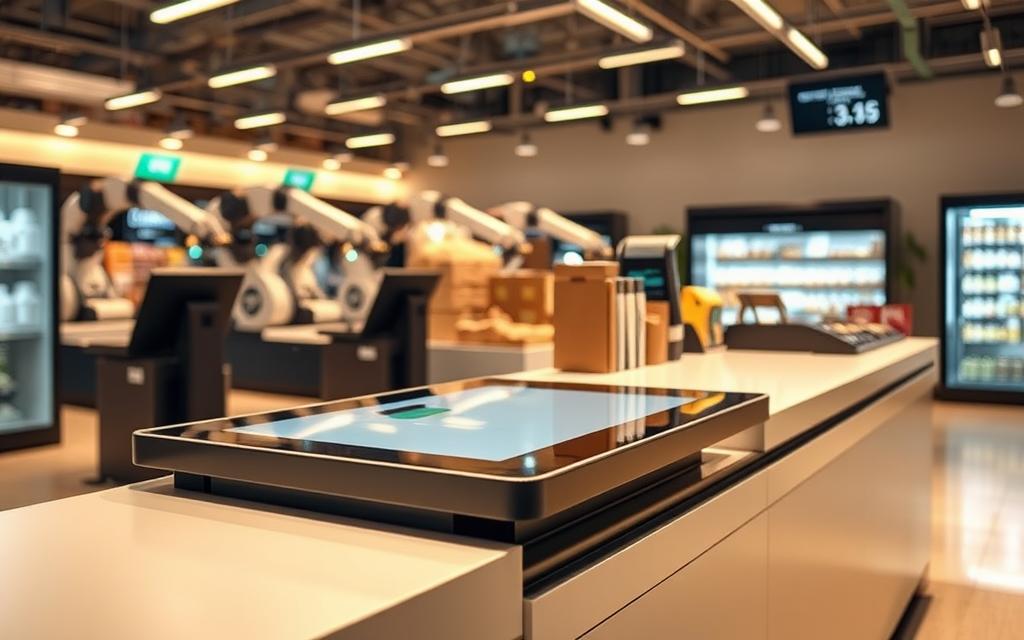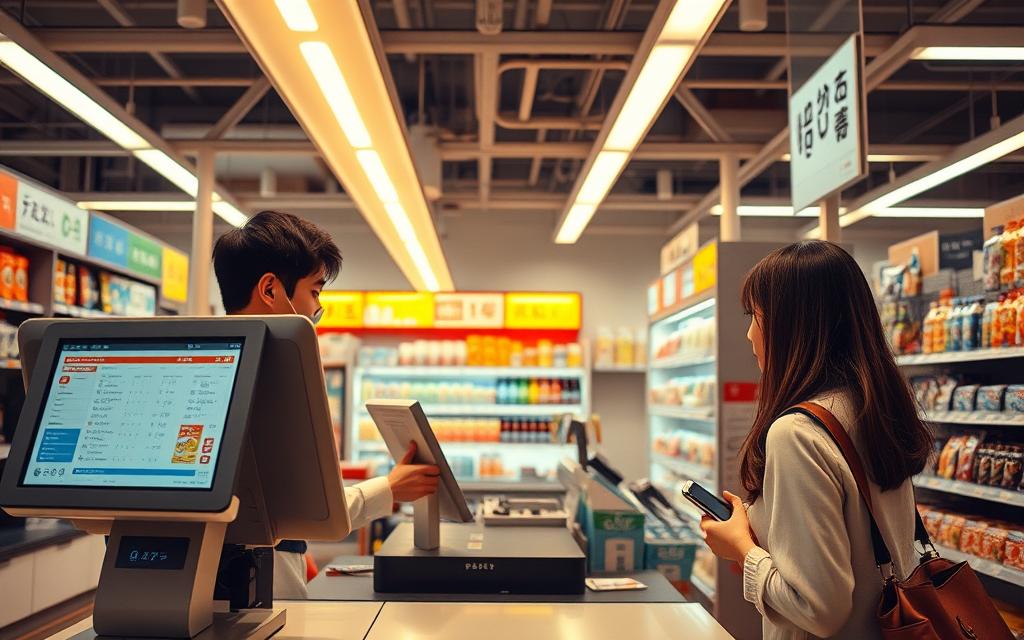Table of Contents
Japan’s retail landscape blends cutting-edge technology with cultural values like efficiency and hospitality. From vending machines to smart toilets, innovation simplifies daily life. Stores extend this ethos with automated systems designed for speed and courtesy.
Over 55,000 convenience stores nationwide rely on these solutions. Partnerships like Fujitsu and Zippin pilot checkout-free experience, catering to customers and tourists. The focus? Seamless service that saves time while respecting tradition.
The Cultural Roots of Talking Checkout Computers in Japan
Labor shortages and aging demographics drive retail automation. With 28% of the population over 65 and 61% of konbini owners reporting labor gaps, stores turn to tech for solutions. Japan’s Ministry of Economy (METI) backs this shift, funding pilots like Fujitsu’s palm-reader checkout systems.
Efficiency in High-Traffic Retail Environments
Kyushu supermarkets test dual-cashier lanes to speed up transactions. These setups let customers scan items while staff handle payment, cutting wait times by 40%. METI’s 2017 automation push accelerated such innovations, prioritizing convenience in crowded urban stores.
Politeness and Customer Service as a Priority
Automated systems echo Japan’s respect culture. Voice prompts say *“arigatou gozaimasu”* (thank you) after each purchase. Tourists appreciate English/Chinese options, while locals value the familiar courtesy. This programming bridges tech and tradition, making shopping feel personal.
Accessibility for an Aging Population and Tourists
Cashless adoption rose post-COVID, aiding non-Japanese speakers. Lawson’s Fujitsu pilot uses palm scans for contactless checkout, ideal for seniors and travelers. Such features address two needs: a shrinking workforce and growing tourist influx.
- METI’s 2017 initiative: ¥2B budget for retail automation.
- Zippin tech: AI tracks items without barcodes.
- Multilingual menus: Support 8 languages in major cities.
How the Technology Behind Talking Checkout Systems Works
Advanced voice-guided retail solutions transform shopping into a seamless experience. These systems combine voice synthesis, AI, and sensor networks to streamline transactions. The result? Faster service, fewer errors, and a touch of hospitality.

Voice Synthesis and Recognition
Natural-sounding voice prompts guide customers through each step. Text-to-speech tools like Fujitsu’s Kibiro mimic human intonation for clarity. Multilingual support ensures tourists hear instructions in their preferred language.
Integration with AI and Payment Systems
AI cameras monitor carts for unpurchased items, reducing theft risks. Zippin’s grab-and-go technology uses sensor fusion to track products without barcodes. Payments sync instantly with e-wallets or palm-scanning systems, like Lawson’s Fujitsu pilot.
RFID and Sensor Technologies
While RFID tags offer precise tracking, their cost limits widespread adoption. Instead, retailers prefer camera-based technology for affordability. METI’s funding accelerated these innovations, prioritizing scalable solutions.
- AI error detection: Flags misplaced items during self-checkout.
- Palm authentication: Fujitsu’s system cuts transaction time by 30%.
- Sustainability: Digital receipts reduce paper waste by 15% annually.
“Camera-sensor fusion outperforms RFID in high-traffic environments, balancing accuracy and operational costs.”
Customer Reactions and the Shopping Experience
Visitors and locals alike share mixed reactions to Japan’s voice-guided checkout solutions. These systems blend innovation with cultural nuances, creating unique experiences for different groups. From tourists marveling at multilingual menus to seniors appreciating audible instructions, feedback reveals tech’s role in modern retail.
Tourists’ Fascination with the System
International shoppers often describe these systems as “futuristic.” Support for eight languages helps travelers navigate purchases effortlessly. Stores in Tokyo and Osaka report higher satisfaction scores from tourists using voice-guided checkout compared to traditional methods.
Elderly and Visually Impaired Shoppers’ Feedback
70% of seniors prefer voice-assisted systems over silent self-checkout kiosks. Audible prompts reduce errors and build confidence. For visually impaired customers, verbal instructions are indispensable. Supermarkets like Aeon now deploy wheeled checkout stations to assist mobility-limited shoppers.
Comparing Human Cashiers vs. Automated Systems
Urban areas embrace automation, while rural stores retain human cashiers for personal touch. A 2023 survey highlights this divide:
| Metric | Automated Checkout | Human Cashier |
|---|---|---|
| Speed | 30% faster | More flexible |
| Error Rate | 5% lower | Handles complex transactions |
| Customer Preference | Urban (75%) | Rural (68%) |
IMF data suggests such automation offsets 0.8% annual GDP decline from aging demographics. As automated checkout technology evolves, its balance of efficiency and accessibility will define retail’s future.
Conclusion
Global retailers look East for futuristic checkout inspiration. Japan’s store systems blend cultural respect with technology, setting a benchmark for efficiency.
Fujitsu and Zippin lead with cashless experience, from palm scans to AI tracking. These solutions prioritize convenience while addressing labor gaps.
The future? Biometric authentication and personalized greetings will reshape retail. US markets can learn from Japan’s harmony of tradition and technology.
Visit and witness innovation that feels human.
FAQ
What makes Japanese retail technology different from other countries?
Japan integrates advanced technology like voice-enabled checkout systems to enhance customer experience, blending efficiency with cultural values of politeness.
How do talking machines improve the shopping experience?
These systems speed up transactions, reduce labor costs, and assist shoppers, especially the elderly or visually impaired, making purchases smoother.
Are human cashiers being replaced by automated systems?
While automation handles routine tasks, staff still assist with complex items or personalized service, balancing technology with human interaction.
How do vending machines and retail systems use RFID?
A: RFID tags track items instantly, enabling seamless payment and inventory management, common in convenience stores and vending solutions.
Why is Japan a leader in retail automation?
A shrinking population and high customer expectations drive innovation, making stores adopt smart systems to save time and improve service.









